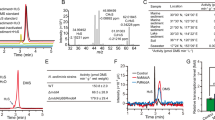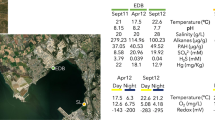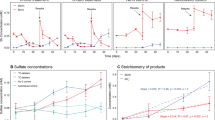Abstract
Methylmercury is a neurotoxin that poses significant health risks to humans. Some anaerobic sulphate- and iron-reducing bacteria can methylate oxidized forms of mercury, generating methylmercury1,2,3,4. One strain of sulphate-reducing bacteria (Desulfovibrio desulphuricans ND132) can also methylate elemental mercury5. The prevalence of this trait among different bacterial strains and species remains unclear, however. Here, we compare the ability of two strains of the sulphate-reducing bacterium Desulfovibrio and one strain of the iron-reducing bacterium Geobacter to oxidize and methylate elemental mercury in a series of laboratory incubations. Experiments were carried out under dark, anaerobic conditions, in the presence of environmentally relevant concentrations of elemental mercury. We report differences in the ability of these organisms to oxidize and methylate elemental mercury. In line with recent findings5, we show that D. desulphuricans ND132 can both oxidize and methylate elemental mercury. We find that the rate of methylation of elemental mercury is about one-third the rate of methylation of oxidized mercury. We also show that Desulfovibrio alaskensis G20 can oxidize, but not methylate, elemental mercury. Geobacter sulphurreducens PCA is able to oxidize and methylate elemental mercury in the presence of cysteine. We suggest that the activity of methylating and non-methylating bacteria may together enhance the formation of methylmercury in anaerobic environments.
This is a preview of subscription content, access via your institution
Access options
Subscribe to this journal
Receive 12 print issues and online access
$259.00 per year
only $21.58 per issue
Buy this article
- Purchase on Springer Link
- Instant access to full article PDF
Prices may be subject to local taxes which are calculated during checkout


Similar content being viewed by others
References
Parks, J. M. et al. The genetic basis for bacterial mercury methylation. Science 339, 1332–1335 (2013).
Jay, J. A. et al. Mercury methylation by Desulfovibrio desulfuricans ND132 in the presence of polysulfides. Appl. Environ. Microbiol. 68, 5741–5745 (2002).
Gilmour, C. C. et al. Sulfate-reducing bacterium Desulfovibrio desulfuricans ND132 as a model for understanding bacterial mercury methylation. Appl. Environ. Microbiol. 77, 3938–3951 (2011).
Schaefer, J. K. et al. Active transport, substrate specificity, and methylation of Hg(II) in anaerobic bacteria. Proc. Natl Acad. Sci. USA 108, 8714–8719 (2011).
Colombo, M. J., Ha, J., Reinfelder, J. R., Barkay, T. & Yee, N. Anaerobic oxidation of Hg(0) and methylmercury formation by Desulfovibrio desulfuricans ND132. Geochim. Cosmochim. Acta 112, 166–177 (2013).
Barkay, T., Miller, S. M. & Summers, A. O. Bacterial mercury resistance from atoms to ecosystems. Fems Microbiol. Rev. 27, 355–384 (2003).
Blum, J. D. Marine chemistry: Marine mercury breakdown. Nature Geosci. 4, 139–140 (2011).
Amyot, M., Morel, F. M. M. & Ariya, P. A. Dark oxidation of dissolved and liquid elemental mercury in aquatic environments. Environ. Sci. Technol. 39, 110–114 (2005).
Peretyazhko, T., Charlet, L., Muresan, B., Kazimirov, V. & Cossa, D. Formation of dissolved gaseous mercury in a tropical lake (Petit-Saut reservoir, French Guiana). Sci. Total Environ. 364, 260–271 (2006).
Bouffard, A. & Amyot, M. Importance of elemental mercury in lake sediments. Chemosphere 74, 1098–1103 (2009).
Andersson, M. E., Sommar, J., Gardfeldt, K. & Lindqvist, O. Enhanced concentrations of dissolved gaseous mercury in the surface waters of the Arctic Ocean. Mar. Chem. 110, 190–194 (2008).
Bone, S. E., Charette, M. A., Lamborg, C. H. & Gonneea, M. E. Has submarine groundwater discharge been overlooked as a source of mercury to coastal waters? Environ. Sci. Technol. 41, 3090–3095 (2007).
Brooks, S. C. & Southworth, G. R. History of mercury use and environmental contamination at the Oak Ridge Y-12 Plant. Environ. Pollut. 159, 219–228 (2011).
Siciliano, S. D., O’Driscoll, N. J. & Lean, D. R. S. Microbial reduction and oxidation of mercury in freshwater lakes. Environ. Sci. Technol. 36, 3064–3068 (2002).
Wiatrowski, H. A., Ward, P. M. & Barkay, T. Novel reduction of mercury(II) by mercury-sensitive dissimilatory metal reducing bacteria. Environ. Sci. Technol. 40, 6690–6696 (2006).
Smith, T., Pitts, K., McGarvey, J. A. & Summers, A. O. Bacterial oxidation of mercury metal vapor, Hg(0). Appl. Environ. Microbiol. 64, 1328–1332 (1998).
Gu, B. et al. Mercury reduction and complexation by natural organic matter in anoxic environments. Proc. Natl Acad. Sci. USA 108, 1479–1483 (2011).
Zheng, W., Liang, L. & Gu, B. Mercury reduction and oxidation by reduced natural organic matter in anoxic environments. Environ. Sci. Technol. 46, 292–299 (2012).
Michelon, D. et al. Contribution of exofacial thiol groups in the reducing activity of Lactococcus lactis. FEBS J. 277, 2282–2290 (2010).
Culha, M. et al. Characterization of thermophilic bacteria using surface-enhanced Raman scattering. Appl. Spectrosc. 62, 1226–1232 (2008).
Toyo’oka, T. Review Recent advances in separation and detection methods for thiol compounds in biological samples. J. Chromatogr. B. 877, 3318–3330 (2009).
Hauser, L. J. et al. Complete genome sequence and updated annotation of Desulfovibrio alaskensis G20. J. Bacteriol. 193, 4268–4269 (2011).
Lamborg, C. H., Tseng, C. M., Fitzgerald, W. F., Balcom, P. H. & Hammerschmidt, C. R. Determination of the mercury complexation characteristics of dissolved organic matter in natural waters with ‘reducible Hg’ titrations. Environ. Sci. Technol. 37, 3316–3322 (2003).
Miller, C., Southworth, G., Brooks, S. C., Liang, L. & Gu, B. Kinetic controls on the complexation between mercury and dissolved organic matter in a contaminated environment. Environ. Sci. Technol. 43, 8548–8553 (2009).
Margel, S. & Hirsh, J. Reduction of organic mercury in water, urine, and blood by sodium-borohydride for direct determination of total mercury content. Clin. Chem. 30, 243–245 (1984).
Bramanti, E., D’Ulivo, A., Lampugnani, L., Zamboni, R. & Raspi, G. Application of mercury cold vapor atomic fluorescence spectrometry to the characterization of mercury-accessible -SH groups in native proteins. Anal. Biochem. 274, 163–173 (1999).
Biswas, A. et al. Bacterial growth phase influences methylmercury production by the sulfate-reducing bacterium Desulfovibrio desulfuricans ND132. Sci. Total Environ. 409, 3943–3948 (2011).
Cohen-Atiya, M. & Mandler, D. Studying thiol adsorption on Au, Ag and Hg surfaces by potentiometric measurements. J. Electroanal. Chem. 550, 267–276 (2003).
Joe-Wong, C., Shoenfelt, E., Hauser, E. J., Crompton, N. & Myneni, S. C. B. Estimation of reactive thiol concentrations in dissolved organic matter and bacterial cell membranes in aquatic systems. Environ. Sci. Technol. 46, 9854–9861 (2012).
Schaefer, J. K. & Morel, F. M. M. High methylation rates of mercury bound to cysteine by Geobacter sulfurreducens. Nature Geosci. 2, 123–126 (2009).
Acknowledgements
We thank X. Yin, Y. Qian, R. Jr Hurt and M. Drake at Oak Ridge National Laboratory (ORNL) and H. Guo at the University of Tennessee for technical assistance and support. This research was sponsored by the Office of Biological and Environmental Research, Office of Science, US Department of Energy (DOE) as part of the Mercury Science Focus Area Program at ORNL, which is managed by UT-Battelle LLC for the DOE under contract DE-AC05-00OR22725.
Author information
Authors and Affiliations
Contributions
H.H. and H.L. designed and carried out the experiments; B.G. conceived the study and supervised the research; W.Z., S.J.T. and X.F. contributed experiments and analytic tools; B.G., A.J., D.A.E. and L.L. contributed data analysis and wrote the paper.
Corresponding author
Ethics declarations
Competing interests
The authors declare no competing financial interests.
Supplementary information
Supplementary Information
Supplementary Information (PDF 660 kb)
Rights and permissions
About this article
Cite this article
Hu, H., Lin, H., Zheng, W. et al. Oxidation and methylation of dissolved elemental mercury by anaerobic bacteria. Nature Geosci 6, 751–754 (2013). https://doi.org/10.1038/ngeo1894
Received:
Accepted:
Published:
Issue Date:
DOI: https://doi.org/10.1038/ngeo1894
This article is cited by
-
Light-independent phytoplankton degradation and detoxification of methylmercury in water
Nature Water (2023)
-
Global change effects on biogeochemical mercury cycling
Ambio (2023)
-
A synthesis of mercury research in the Southern Hemisphere, part 2: Anthropogenic perturbations
Ambio (2023)
-
Microbial methylation potential of mercury sulfide particles dictated by surface structure
Nature Geoscience (2021)
-
Remediation of mercury-contaminated soils and sediments using biochar: a critical review
Biochar (2021)



